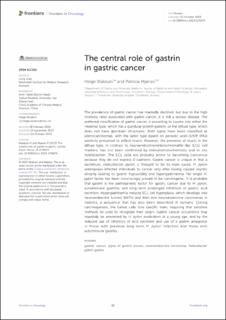| dc.description.abstract | The prevalence of gastric cancer has markedly declined, but due to the high mortality rates associated with gastric cancer, it is still a serious disease. The preferred classification of gastric cancer is according to Lauren into either the intestinal type, which has a glandular growth pattern, or the diffuse type, which does not have glandular structures. Both types have been classified as adenocarcinomas, with the latter type based on periodic acid–Schiff (PAS) positivity presumed to reflect mucin. However, the presence of mucin in the diffuse type, in contrast to neuroendocrine/enterochromaffin-like (ECL) cell markers, has not been confirmed by immunohistochemistry and in situ hybridization. The ECL cells are probably prone to becoming cancerous because they do not express E-cadherin. Gastric cancer is unique in that a bacterium, Helicobacter pylori, is thought to be its main cause. H. pylori predisposes infected individuals to cancer only after having caused oxyntic atrophy leading to gastric hypoacidity and hypergastrinemia. No single H. pylori factor has been convincingly proved to be carcinogenic. It is probable that gastrin is the pathogenetic factor for gastric cancer due to H. pylori, autoimmune gastritis, and long-term prolonged inhibition of gastric acid secretion. Hypergastrinemia induces ECL cell hyperplasia, which develops into neuroendocrine tumors (NETs) and then into neuroendocrine carcinomas in rodents, a sequence that has also been described in humans. During carcinogenesis, the tumor cells lose specific traits, requiring that sensitive methods be used to recognize their origin. Gastric cancer occurrence may hopefully be prevented by H. pylori eradication at a young age, and by the reduced use of inhibitors of acid secretion and use of a gastrin antagonist in those with previous long-term H. pylori infection and those with autoimmune gastritis. | en_US |

